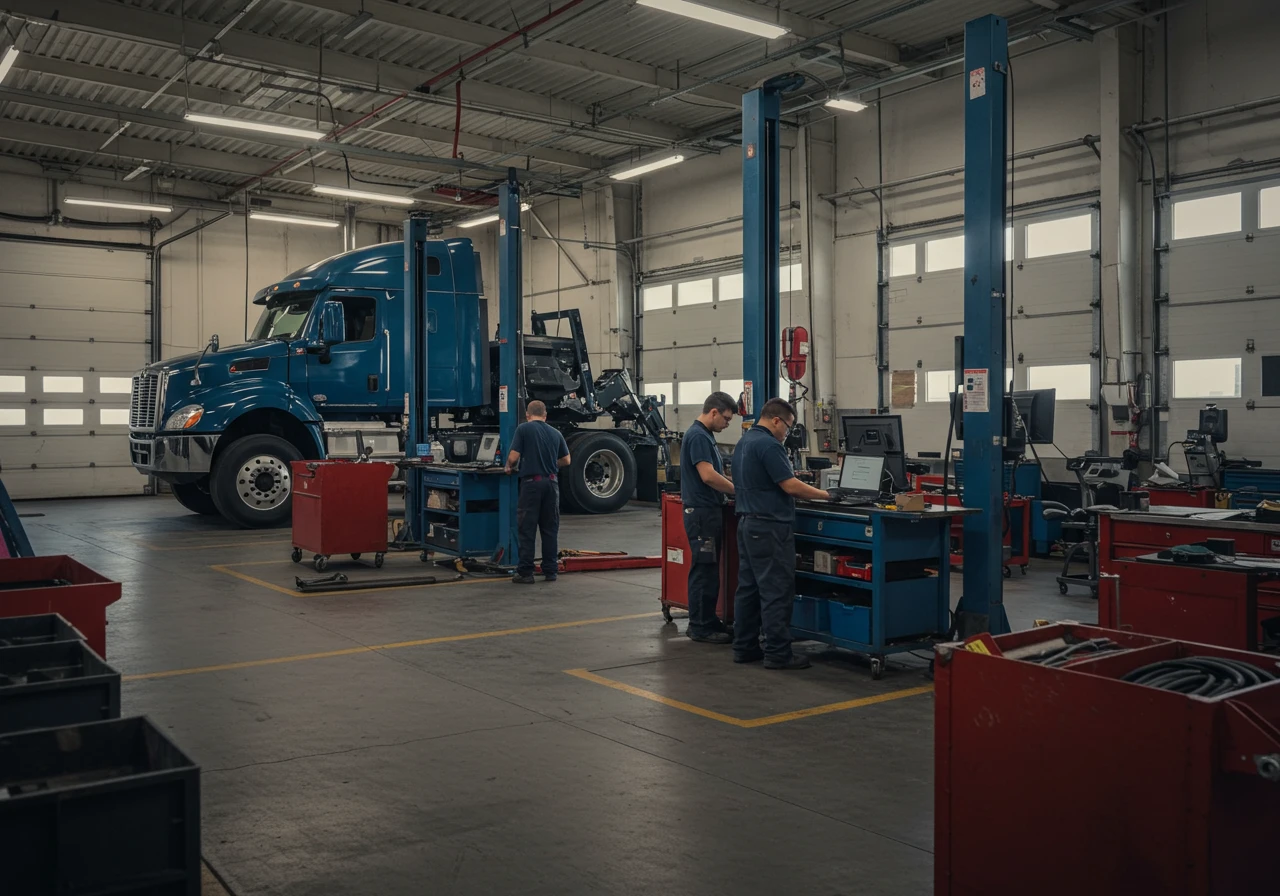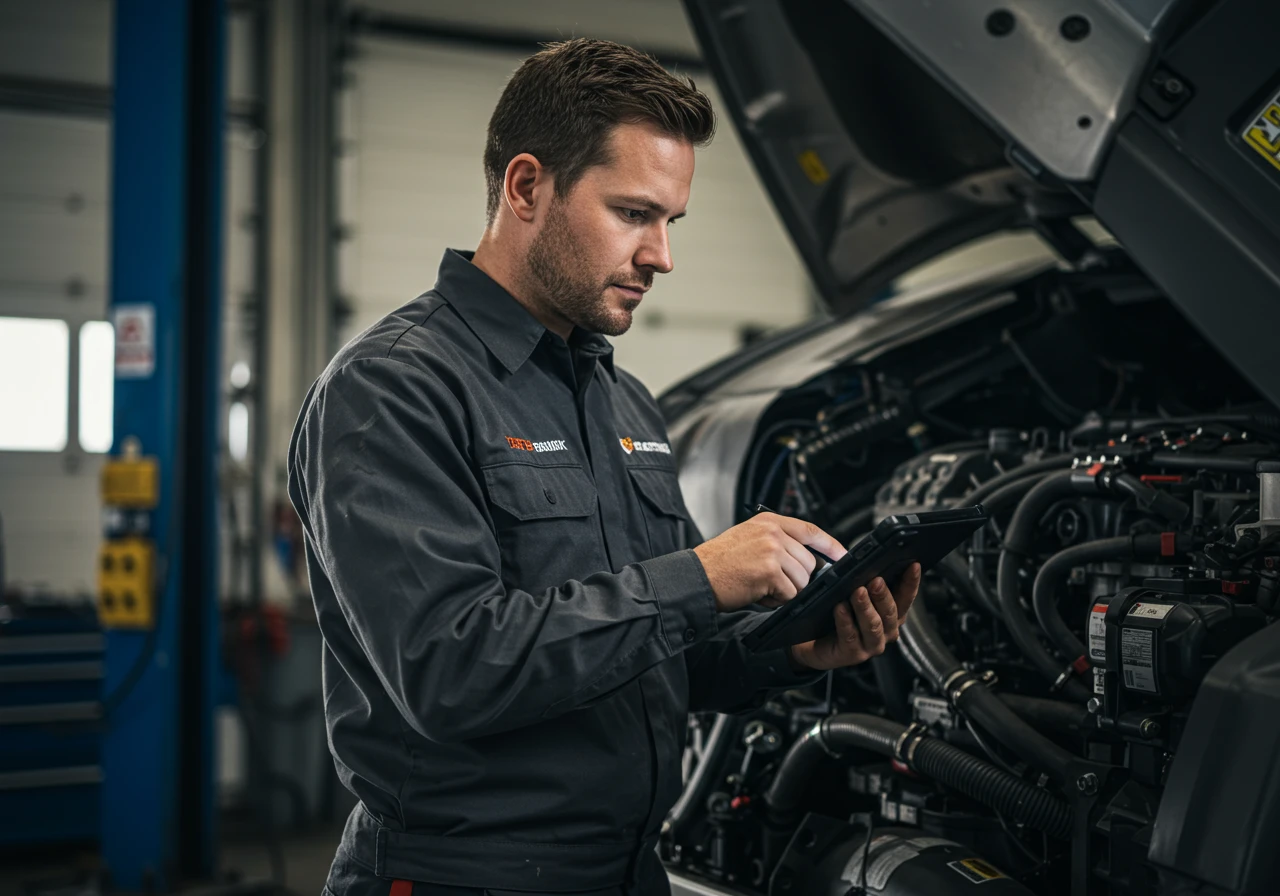

A profitable repair shop runs on more than just skilled technicians; it runs on a flawless workflow supported by smart business decisions. An unstructured shop floor leads to communication breakdowns and lost revenue. You can transform that chaos into a predictable, high-performing operation by mastering a disciplined, step-by-step process.
This guide provides the complete blueprint, placing the core 6-step workflow at the center of your business.
Step 1: Proactive Scheduling & Customer Intake
Your work begins long before a truck enters the bay. This initial step is where you apply your business strategy to fill your schedule with the right kind of work from the right kind of customers.
Target Your Ideal Customer
You must decide whether to serve businesses (B2B) or individual owners (B2C). B2B work with fleets is often more profitable. Business customers view vehicles as revenue-generating assets and are less emotional about repair costs, focusing instead on quality and speed.
Find Your Niche
Analyze your local market. Are you near farms, a port, or a construction hub? Specializing in agricultural equipment, marine diesels, or "yellow iron" machinery can make you the go-to expert and allow you to command higher rates.
Secure an Anchor Fleet
Proactively secure a few key fleet accounts to handle all their Preventive Maintenance (PMs). These "anchor fleets" provide a steady stream of revenue that can cover your fixed overhead costs each month. With your baseline costs covered, every other job contributes directly to your profit.
For every appointment, prepare a work order in advance that includes company information, unit number, and all requested services to streamline the entire process.
Step 2: Flawless Check-In & Accurate Estimates
A consistent and professional check-in process sets the tone for the entire repair.
Gather and verify all essential customer and vehicle data, including VINs and unit numbers. Accurate records are your best defense against payment disputes. Next, create a transparent estimate. Be upfront about diagnostic fees and other charges. Your labor rate signals your quality; set it to attract clients who value reliability, not just the lowest price. Best practice is to review your labor rates at least quarterly to keep pace with market changes.
Always secure a signed authorization before you begin any work.

Step 3: Smart Diagnosis & Work Delegation
This step is about a clear and efficient handoff to your technical team.
Assign the work order to a technician with absolute clarity. Ensure they have the estimate and all customer notes. If the job involves diagnostics, the technician must meticulously document their observations, take photos, and record specific recommendations. This detailed documentation prevents miscommunication and provides the evidence you need to explain additional necessary repairs.
Step 4: Efficient Service Execution & Team Management
The quality of your work is paramount, but so is the efficiency of your team. This is where your people and culture drive profitability.
During the repair, the technician must carefully track all labor time and list every part used. These details are critical for an accurate final invoice.
Maximize Technician Productivity
Structure your shop for maximum output by aiming for a ratio of 1.5 to 2 service bays per technician. This strategy is crucial. It allows a technician to start a second job if the first is held up waiting for a part, dramatically reducing bottlenecks and increasing your shop's total billable hours.
Invest in Your Team
In an industry facing a technician shortage, you must adopt an "always be hiring" mindset by constantly networking. Invest in your team's growth with structured training, paying for certifications, or establishing an apprenticeship program. Creating a path for career advancement builds loyalty that money cannot buy.

Step 5: The Profitability Audit & Invoice Review
Before you present an invoice, you must audit it for accuracy and profitability. This non-negotiable step ensures you capture the full value of your work.
The Ideal Profit Formula
A healthy shop should target this profit structure for every job:
- 25% Parts Cost
- 20% Labor Cost
- 30% Overhead
- 25% Net Profit Margin
Measure every invoice against these benchmarks. If your numbers are off, you know exactly where to make adjustments.
Your Profit Checklist
- Verify All Services: Is every task documented and billed correctly?
- Confirm Labor Accuracy: Are all hours accounted for at the proper rate?
- Check Part Markups: Are parts priced with a strategic markup, not a flat percentage? A strategic approach accounts for the "hidden costs" of a part, like ordering time and storage.
- Include All Fees: Have you added standard charges for shop supplies and hazardous waste disposal? These are real costs that must be recovered.
Step 6: Final Authorization & Financial Protection
The job is not complete until the money is in your bank. This final step is about securing payment and protecting your business from risk.
Present the finalized, audited invoice to the customer for their approval. You must collect a final signature before releasing the vehicle to protect your shop from disputes. Secure payment immediately or confirm any pre-approved payment terms.
Understand Profit vs. Cash Flow
You must understand this critical difference. A job is "profitable" on paper when you create the invoice. But you only have positive "cash flow" when the payment is in your bank. Be selective about extending credit to manage this gap.
Guard Against Fraud & Problem Customers
Fraud is a real threat. Protect your business with smart policies like verifying new customer information and requiring photo ID for credit card payments over the phone. Finally, know when to fire a customer. A client who constantly disputes charges or pays late costs you more than their business is worth. Focus on building a base of respectful, reliable customers.
By integrating this complete workflow, you move beyond simply fixing trucks. You build a resilient, predictable, and highly profitable business.
Easy Truck Shop (ETS): The All-in-One Workflow Solution
If you want to streamline your heavy-duty repair shop workflow, Easy Truck Shop (ETS) is purpose-built for your needs. ETS covers every step of the process; from proactive scheduling and digital check-in to technician documentation, inventory management, and real-time profitability audits. With ETS, you can:
- Automate preventive maintenance schedules and customer reminders
- Digitize check-in and estimate creation for faster, more accurate service
- Empower technicians to upload photos, notes, and parts used directly from the bay
- Track labor efficiency and manage team performance with built-in dashboards
- Ensure every invoice is accurate and profitable using integrated markup and fee tools
- Collect payments securely and monitor cash flow with Stripe integration
ETS is designed for heavy-duty repair shops that value efficiency, transparency, and growth. By centralizing your workflow and business management in one platform, you reduce errors, boost productivity, and maximize profit on every job.
Ready to see how ETS can transform your shop? Learn more about Easy Truck Shop’s workflow management features.
FAQ: Heavy-Duty Repair Shop Workflow & ETS Solutions
What is the most important step in a heavy-duty repair shop workflow?
Proactive scheduling and customer intake is essential. Using ETS workflow management tools helps you stay organized and ensures every appointment and PM is tracked.
How can ETS help speed up my check-in process?
ETS digitizes check-ins, auto-fills customer and vehicle data, and reduces front desk errors. Learn more about workflow automation.
Why is technician documentation so critical?
Accurate documentation with photos, notes, and part usage prevents miscommunication. ETS estimating software lets techs update jobs in real time so your entire team stays aligned.
How do I maximize technician productivity?
Optimizing your shop layout and tracking efficiency is easy with ETS team management features. This helps you spot bottlenecks and reward top performers.
What’s the best way to ensure invoices are profitable?
Audit every invoice for accuracy and use profit calculators and markup tools to make sure you capture all your revenue.
How do I handle payment disputes or late payments?
Always collect signed authorizations and track payments with ETS payment processing and Stripe integration. You can set credit limits and require prepayment for risky accounts.
What are anchor fleets and why do they matter?
Anchor fleets are regular, high-volume clients whose PMs and repairs cover your fixed costs.
How should I set my labor rates and parts markup?
Review rates quarterly, benchmark against other shops, and use ETS labor guide and estimating tools for dynamic pricing.
How can I reduce shop supply costs and charge appropriately?
Track consumables with ETS inventory management and add standard supply fees to invoices to recover real costs.
Why should I choose ETS for my heavy-duty shop?
ETS is designed for heavy-duty repair shops. It streamlines workflow, improves communication, manages PMs, and helps you maximize profit on every job.
Related Articles
Discover more articles on related topics to expand your knowledge.

21 Pro Tips on How to Run a Successful Mechanic Shop


